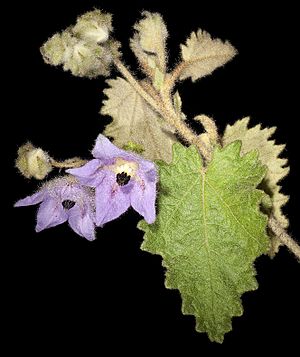Large-fruited thomasia facts for kids
Quick facts for kids Large-fruited thomasia |
|
|---|---|
 |
|
 |
|
| Scientific classification | |
| Genus: |
Thomasia
|
| Species: |
macrocarpa
|
Thomasia macrocarpa, also known as the large-fruited thomasia, is a special type of shrub. It grows only in the southwest part of Western Australia. This means it's endemic to that area, like a plant native only to one specific place!
What Does It Look Like?
Thomasia macrocarpa is a small, bushy plant. It usually grows to about 1.5 meters (about 5 feet) tall. It can spread out to about 1 meter (about 3 feet) wide.
Its stems are a bit hairy. The leaves are grey-green. They can be 30 to 120 millimeters (about 1 to 5 inches) long. They are also 15 to 70 millimeters (about 0.5 to 3 inches) wide. The edges of the leaves have tiny teeth. They are covered in cool star-shaped hairs!
When the leaves are young, they feel soft and velvety. As they get older, they become smooth. Their shape can be like a heart or an egg.
Flowers and Fruit
This plant produces beautiful pink to purple flowers. You can usually see them between August and November in Western Australia. Sometimes, you might even spot white flowers!
Each flower is about 10 millimeters (about 0.4 inches) across. They have small, petal-like parts called lobes. The surface of these parts is covered in star-shaped hairs. The flowers grow on stalks that are 7 to 15 millimeters (about 0.3 to 0.6 inches) long.
After the flowers, the plant grows small capsules. These capsules hold black seeds. When the seeds are ready, they fall off the plant.
How It Got Its Name
The plant Thomasia macrocarpa was first officially described in 1839. An Austrian botanist named Stephan Endlicher gave it its name. He wrote about it in a book called Novarum Stirpium Decades.
The second part of its scientific name, macrocarpa, comes from two old Greek words. Makros (μακρός) means "long." Karpos (καρπός) means "fruit." So, "macrocarpa" means "long-fruited," which fits its common name, "large-fruited thomasia."

